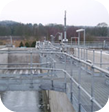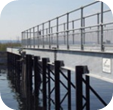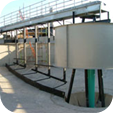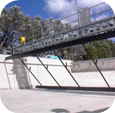Settlement Tanks Scrapers
- Side wall scrapers
- Weir and channel cleaning facilities
- Scum skimming and removal
- Steel centre support assembly
- Plain, vee notch or castellated weirs
- Double sided weir troughs
- Continual or automatic desludging controls
- Peripheral speed choice
- Winch-up scraper blades
General Description:
We manufacture a complete range of settlement tank scrapers to suit any tank profile, and which are designed to collect and remove any type of sludge. They fall into two main categories; fixed bridge scrapers and rotating bridge scrapers.
Fixed bridge scrapers have a stationary bridge which spans the tank and a scraper which is supported and driven from the centre. Rotating bridge scrapers have one end of the bridge supported and pivoted at the tank’s centre while the other end is mounted on an end carriage that moves around the tank’s outer wall. Fixed bridge scrapers can be provided for tanks with 3m to 30m diameters and rotating bridge scrapers for tanks with diameters from 6m to 45m.
The scrapers themselves can be designed to fit any floor type and can be either fixed, trailing or a combination of the two. In addition, chain type scrapers for steep floor tanks or hydrostatic draw-off tubes and vee scrapers can be provided for flat floored tanks. Scraper drive assemblies are designed for a minimum life of 100,000 hours ie.11 years.
Scraper and Sludge Removal:
The type and design of scraper blade arrangement is dependent on the type of sludge to be removed. Primary or heavy sludges are usually dealt with by hinged scraper blades supported from a fixed framework carried from the bridge.
For secondary humus or activated sludges, trailing scrapers hinged from a rotating bridge are usually recommended. However, hinged scrapers attached to an underwater fixed subframe are sometimes preferred as they have the advantage of both fixed and trailing blades as well as reduced wear to blade edges as the weight of trailing parts is much reduced. This type of scraper arrangement is suitable for all types of sludges including the heavier primary types.
The effectiveness of sludge removal is also greatly influenced by the speed at which the scrapers operate. The type of sludge is a factor in this. With primary sludge types it is possible to operate with the tip of the rotating blade travelling at 2.5m/minute with 1.2m/minute being appropriate for lighter sludges.




